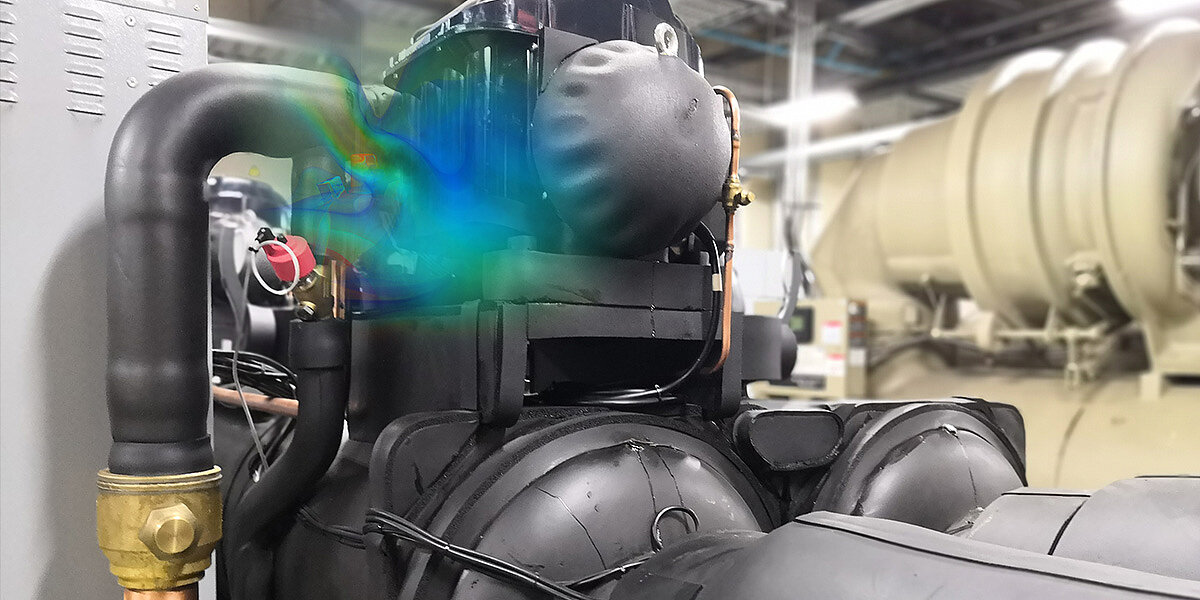New F-Gas Regulation (EU) No. 517/2014 for chillers

The F-Gas Regulation (EU) No. 517/2014 is a major game changer for chiller manufacturers. The goal is to reduce emissions of F-gases (fluorinated hydrocarbons) by 70 percent by 2030 compared to 1990.
The switch from F-gas to flammable media, such as butane or propane, creates new challenges in ensuring the tightness of individual assemblies.
Here you can read how to master the technical challenges of the new regulation with the help of CFD and FEM simulation.
Let's take a closer look at a refrigeration process.
Normally, heat flows from hot to cold. But a refrigerator would not work like that. In cooling, heat is supposed to be transferred from the product to be cooled to the warmer environment.
We know the physical effect when a liquid evaporates that it extracts heat. The human body uses this effect when sweating to cool the body temperature.

In a refrigerator or refrigerating machine there is a so-called refrigeration cycle. Here, a gaseous refrigerant is compressed by a compressor and heated to temperatures above the ambient temperature. Heat is transferred to the colder environment via heat exchangers (in the refrigerator these are the black cooling coils at the back). The refrigerant cools down and liquefies. The refrigerant then flows through a throttle into the evaporator inside the refrigerator to reduce the pressure. There it evaporates and extracts heat from the interior again and then flows as a gas to the compressor (see Figure 1).
On a side note: an exciting question in thermodynamics exams is always whether it gets colder or warmer in a room with an open refrigerator.
The answer to this is: in every technical process, frictional losses occur that are converted into heat. There are also losses in a compressor, the valve and the pipes. The amount of heat given off to the surrounding room is therefore always greater than is dissipated in the refrigerator. Therefore, it always gets warmer in the room.
Gases that can be liquefied at moderate temperatures (in the range of -40°C) can now be used as refrigerants. Physically, this is characterised by the boiling point of the gas, which indicates the transition from the liquid to the gaseous phase for a certain pressure.
In the past, hydrofluorocarbons (CFCs) were used here, which had the advantage of not being flammable or explosive. With the emerging climate discussion, the harmfulness to global warming became a topic of discussion.
A new term was now introduced, the GWP as an abbreviation for "Global Warming Potential", which serves for the global warming or greenhouse potential of a substance. The GWP value of a refrigerant defines its relative global warming potential in relation to CO₂ (also known as CO₂ equivalent). CO2 therefore has the value 1.
Since 1 January 2022, the placing on the market and use of refrigerants with a global warming potential (GWP) ≥ 150 has been banned in the European area for further applications.
What remains are natural refrigerants and synthetic refrigerants with low GWP values. These include ammonia, carbon dioxide, propene, propylene, propane, isobutane, ethane and various synthetic variants.
However, many of these refrigerants can form explosive mixtures with ambient air, so that there is a possible explosion risk in the event of leaks in the refrigeration circuit. Explosion protection must therefore be given increased attention in systems with flammable gases.
The spread of possible gas leaks and zones of explosive concentrations can be determined by means of simulations. We will be happy to support you in considering possible risk scenarios using appropriate simulation models with the aid of CFD flow calculation.
The evaporation process itself as well as the effectiveness of heat exchangers can also be mapped very well using simulation models in the field of FEM or CFD.
In order to avoid leakages as far as possible, high demands are placed on the installed seals. The static strength and fatigue resistance (long-term behaviour) of the seals under pulsating pressure, external vibrations and temperature fluctuations can be evaluated and optimised numerically with FEM simulations.
Send me a short mail or simply reply to the newsletter.
We will be happy to contact you for a non-binding consultation.
Your Stefan Merkle
